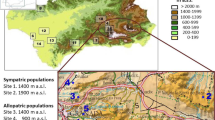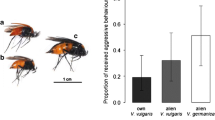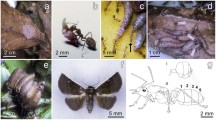Abstract
Females of the obligately parasitic cuckoo ant,Leptothorax kutteri, a workerless inquiline, are among the only adult ants that can successfully invade ant societies and come to be accepted as a nestmate by the existing adult workers. This occurs even though the cuckoo ant is usually severely attacked by theLeptothorax acervorum workers of the colony that she is attempting to enter and parasitize. Through extensive ethogram studies of established parasites and parasitized and free-livingL. acervorum workers and queens, we show that theL. kutteri queen grooms host queens at an exceptionally high frequency. Possibly associated with this behavior, the established parasite is never attacked by theL. acervorum workers or queens she exploits. We show that there is exceptional similarity between the cuticular hydrocarbons and especially the cuticular fatty acids of the parasitic females and her nestmateL. acervorum workers, compared with nonnestmate workers and queens. We suggest that this matching of cuticular compounds may be associated with the grooming of host queens by the parasite. This in turn suggests the possibility that fatty acids have a role in colony-specific nestmate recognition in these and other ants and that grooming may serve for the dissemination of such substances throughout the colony.
Similar content being viewed by others
References
Akre, R.D., andTorgerson, R.L. 1968. The behavior ofDiploeciton nevermanni, a staphylinid beetle associated with army ants.Psyche 75:211–215.
Allies, A.B., Bourre, A.F.G., andFranks, N.R. 1986. Propaganda substances in the cuckoo antLeptothorax kutteri and the slave-makerHarpagoxenus sublaevis.J. Chem. Ecol. 12:1285–1293.
Altmann, J. 1974. Observational study of behaviour. Sampling Methods.Behaviour 49:227–267.
Blum, M.S. 1987. The basis and evolutionary significance of recognitive olfactory acuity in insect societies, pp. 277–294,in J.M. Pasteels and J.L. Deneubourg (eds.). From Individual to Collective Behaviour in Social Insects. Experientia Supplementum 54 Birkhauser Verlag, Basel.
Bonazita-Couoourdan, D., Clement, J.L., andLange, C. 1987. Nestmate recognition: the role of cuticular hydrocarbons in the ant:Camponotus vagus (scop).J. Entomol. Sci. 2:1–10.
Buschinger, A. 1965.Leptothorax (Mychothorax) kutteri n. sp., eine sozial-parasitische Ameise (Hymenoptera, Formicidae)Insectes Soc. 12:327–334.
Buschinger, A. 1973. The role of daily temperature rhythms in brood development of ants of the tribe Leptothoracini (Hymenoptera: Formicidae). In: W. Wieser (ed.). Effect of Temperature on Ectothermic Organisms. Springer Berlin. Heidelberg, New York. pp. 229–232.
Francoeur, A., Loiselle, R., andBuschinger, A. 1985. Biosystematic of the Leptothoracini Tribe (Formicidae, Hymenoptera). The genusFormicoxenus in the Holartic Region.Nat. Can. 112:343–403.
Hölldobler, B. 1970. Zur Physiologie der Gast-Wort-Beziehungen (Myrmecophilie) bei-Ameisen. II. Das Gastverhaltnis des imaginalenAtemeles pubicollis Bris. (Col. Staphylinidae) zuMyrmica undFormica (Hym. Formicidae).Z. Vergl. Physiol. 66:176–189.
Hölldobler, B. 1971. Communication between ants and their guests.Sci. Am. 224(3):86–93.
Kistner, D.H. 1979. Social and evolutionary significance of social insect symbionts, pp. 339–413,in H.R. Hermann (ed.). Social Insects, Vol 1. Academic Press, New York.
Mintzer, A. 1982. Nestmate recognition and incompatibility between colonies of the Acacia antPseudomyrmex ferruginea.Behav. Ecol. Sociobiol. 10:165–168.
Nelson, D.R. 1978. Long chain methyl-branched hydrocarbons; occurrence, biosynthesis and function, pp. 1–33,in J.E. Treherne, M.J. Berridge and V.B. Wigglesworth, (eds.). Advances in Insect Physiology, Vol. 13. Academic Press, Orlando, Florida.
Nelson, D.R., andSukkestad, D.R. 1975. Normal and branches alkanes from cast skins of the grasshopperSchistocerca vaga (Scudder).J. Lipid Res. 16:12–18.
Nelson, D.R., Sukkestad, D.R., andZaylskie, R.G. 1972. Mass spectra of methyl-branched hydrocarbons from eggs of the tobacco budworm.J. Lipid Res. 13:413–421.
Rettenmeyer, C.W. 1961. Arthropods associated with Neotropical army ants with a review of the behavior of these ants. (Arthropoda: Formicidae: Dorylinae). PhD dissertation. University of Kansas.
Smith, R.K. 1989. Chemotaxonomy of honey bees. Part 1: European and African workers. Submitted.
Sudd, J.H., andFranks, N.R. 1987. The Behavioural Ecology of Ants. Blackie, Glasgow.
Vander Meer, R., andWojcik, D. 1982. Chemical mimicry in the myrmecophilous beetleMyrmecaphodius excavaticollis.Science 218:806–808.
Wheeler, W.H. 1910. Ants: Their Structure, Development and Behavior. Columbia University Press, New York.
Wilson, E.O. 1971. The Insect Societies. Belknap Press of Harvard University Press, Cambridge, Massachusetts.
Author information
Authors and Affiliations
Rights and permissions
About this article
Cite this article
Franks, N., Blum, M., Smith, R.K. et al. Behavior and chemical disguise of cuckoo antLeptothorax kutteri in relation to its hostLeptothorax acervorum . J Chem Ecol 16, 1431–1444 (1990). https://doi.org/10.1007/BF01014079
Received:
Accepted:
Issue Date:
DOI: https://doi.org/10.1007/BF01014079




